
Invertebrates
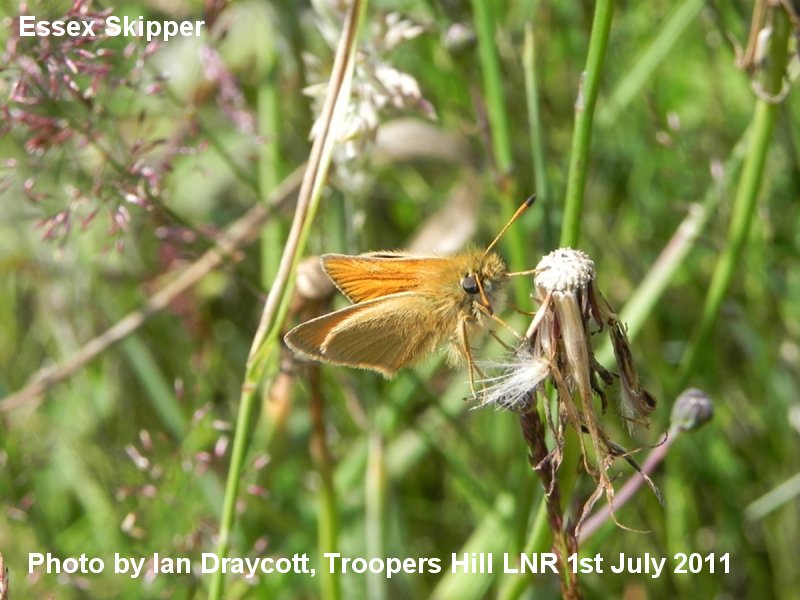 Butterflies
Butterflies
Troopers Hill is alive with butterflies in the spring and summer. Common blues, holly blues, small coppers, marbled white and the beautiful brimstone are all regularly seen. An Essex Skipper was seen in July 2011.
24 species of butterfly have seen in recent years on Troopers Hill.
Solitary Bees
Troopers Hill is the most important site of its type in the Bristol region for bees. There are a large number local rarities and an endangered species, the mining bee, Nomada Guttulata was found in 2000. This and other more common solitary bees nest in the areas of erosion on the hill making these areas of bare ground one of the most important habitats on the site.
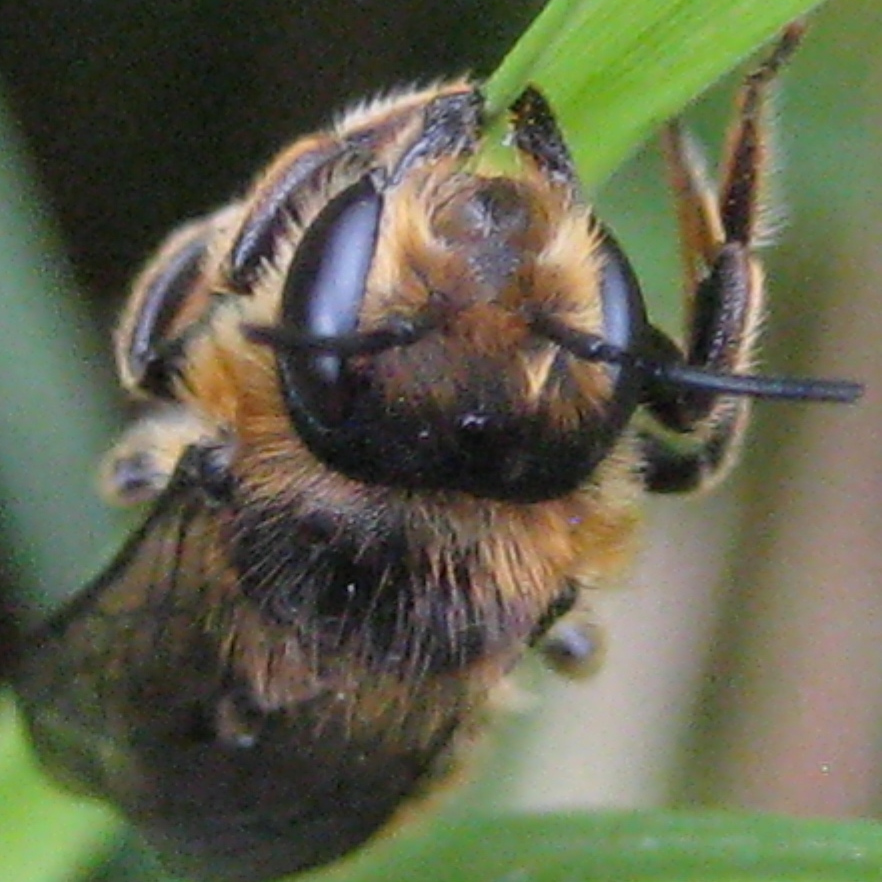 84 different species of bee have now been recorded on Troopers Hill.
84 different species of bee have now been recorded on Troopers Hill.
Two additional species were added in 2023.
In July 2023, a Patchwork Leafcutter Bee (Megachile centuncularis) was seen, with the ID confirmed via the Bees Wasps & Ants Recording Society (BWARS) facebook group (see photo). Though this was a new record for Troopers Hill, the Patchwork Leafcutter Bee is widespread in southern Britain and often found in gardens.
In May 2023 - a Variable Nomad Bee (Nomada zonata) was photographed as part of the City Nature Challenge. This bee appears to be slowly spreading north across the UK, possibly due to Climate Change. We believe this was the first recording of a Variable Nomad Bee in Bristol.
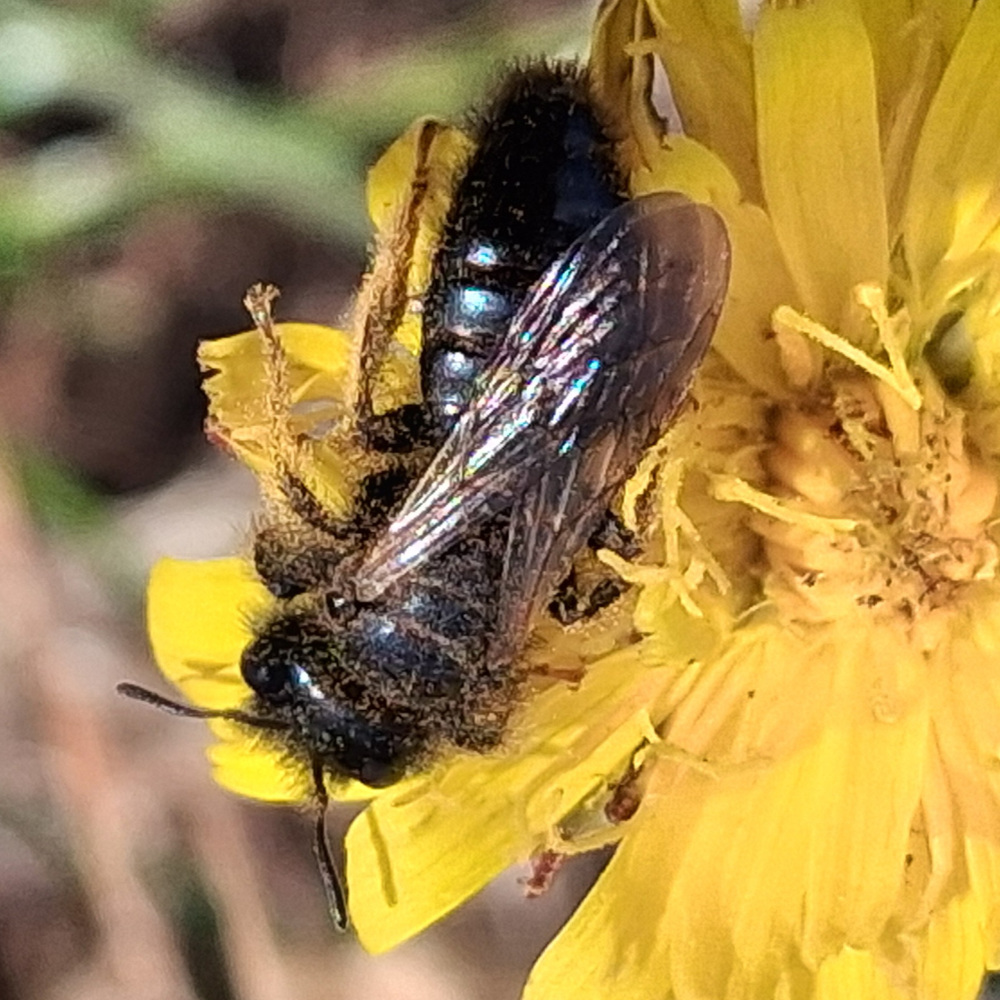
You can learn more about solitary bees and their lifecycle in this excellent Youtube video by Team Candiru:
The Solitary Bees - Team Candiru >>
Solitary bees are native to the UK and important pollinators. It is vital that sites like Troopers Hill are managed to protect their nesting areas and the flowering plants that support them.
You can help native solitary bees by planting plants for pollinators in your garden.
Honeybees - Western honey bee (Apis mellifera) - are not native and if there are too many of them in an area they can out compete solitary bees and bumble bees in the hunt for pollen. Please consider the impact on our native bees if you are thinking about keeping honeybees.
Guardian Sept 2025 - The island that banned hives: can honeybees actually harm nature?
Dave Coulson on You Tube July 2025 - No More Beewashing! Why beekeeping doesn't help conserve bees
"Many companies seek to enhance their green credentials via promoting honeybees. Here I try to explain why this is misguided and potentially harmful for the vast majority of bee species."
Guardian Apr 2024 - The best way to help bees? Don’t become a beekeeper like I did
Kew Gardens Mar 2024 - Bee-ware! Which bees are you really helping?
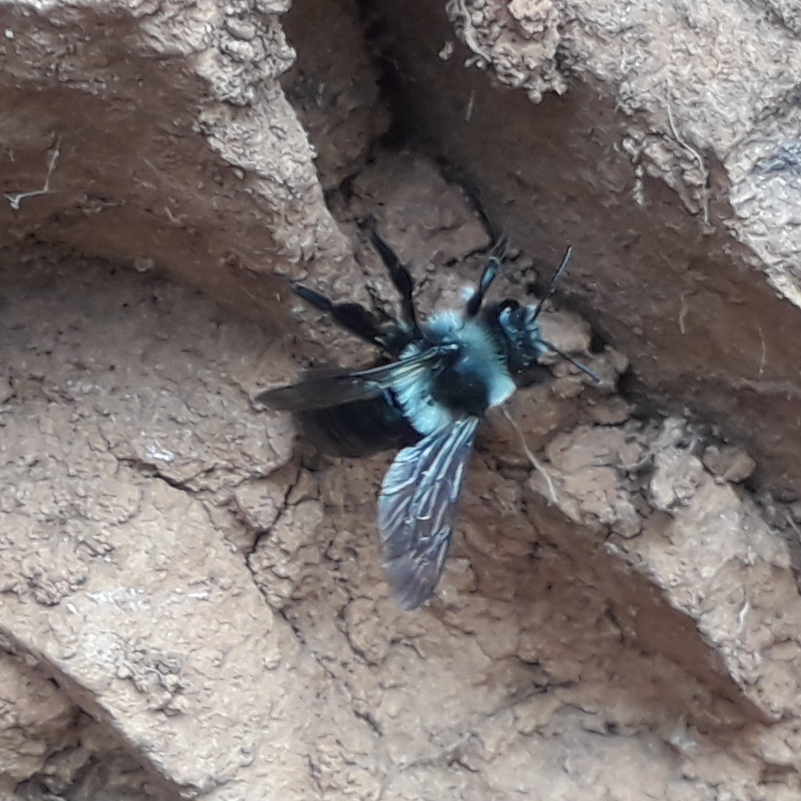 The importance of Troopers Hill for solitary bees as well as invertebrates in general has been confirmed by a series of surveys carried out by local expert David Gibbs, and other local naturalists.
The importance of Troopers Hill for solitary bees as well as invertebrates in general has been confirmed by a series of surveys carried out by local expert David Gibbs, and other local naturalists.
Just four visits in 2007 yielded 262 species of which 30 are considered to be of conservation significance and 6 have Red Data Book (RDB) or equivalent status. RDB status means that the invertebrates are considered to be rare in this country.
Over four visits to Troopers Hill in 2019, David recorded 321 species of invertebrates. This included 44 species of bee, 6 of which had not been included on our records for Troopers Hill before.
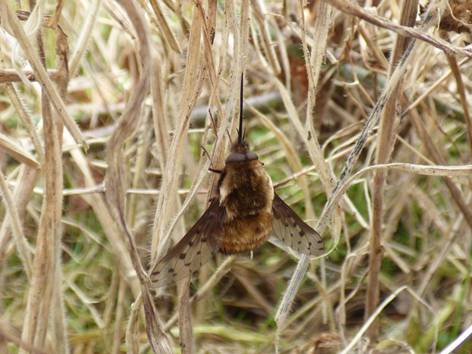 Beeflies
Beeflies
Beeflies are another important resident of Troopers Hill. The Dotted beefly is a robust furry insect with
conspicuous spots on the wings and Troopers Hill is the most important colony in the City.
Formerly this was a
widespread and frequent fly of the southern
half of England and Wales but it has undergone a dramatic decline, it is a parasitoid of mining bees. The darkedge beefly is also present.

Reptiles
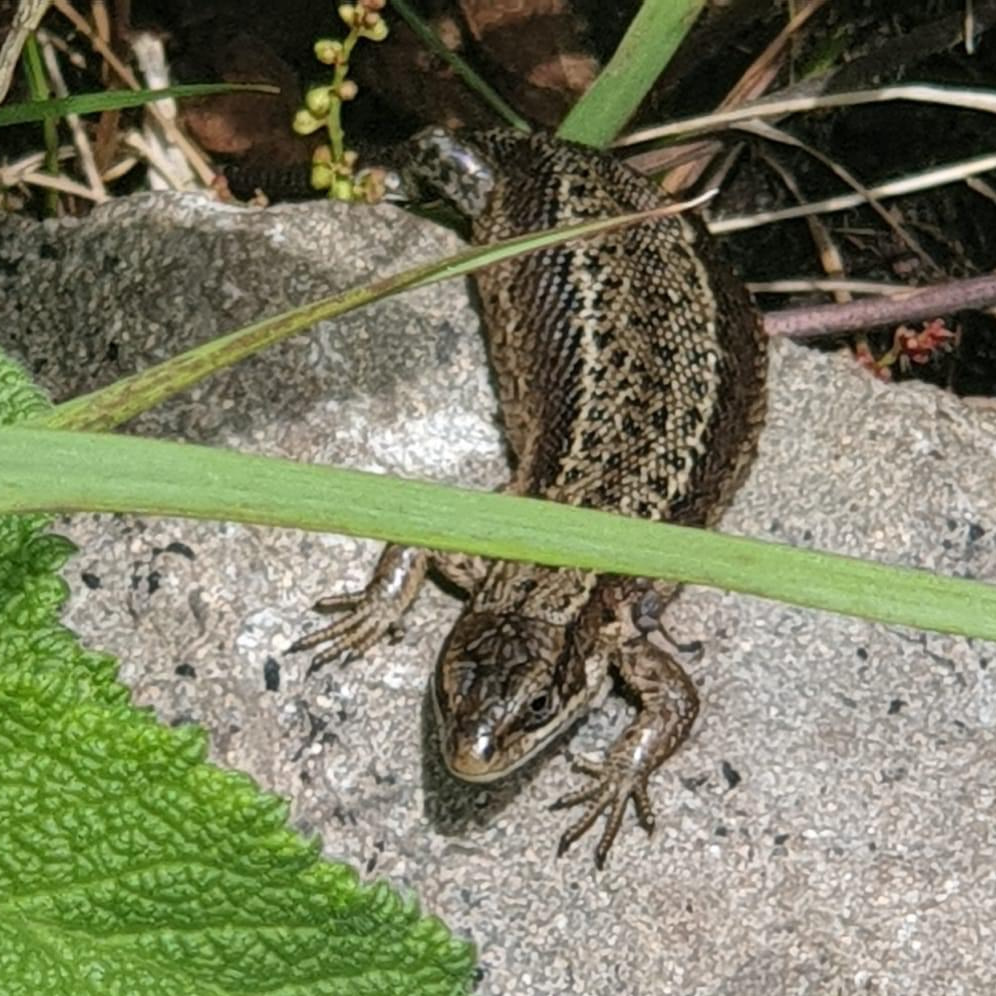 Keri, took this picture a few metres from the flag on the Greendown entrance in Spring 2020.
Keri, took this picture a few metres from the flag on the Greendown entrance in Spring 2020.
It shows a common lizard which is one of two species of reptile that can be seen on Troopers Hill if you are very lucky.
The other reptile known to be resident is the slow worm, which although it looks more like a snake is in fact a leggless lizard.
Local people also report that there used to be adders on the Hill, but there haven't been any recent confirmed sightings.

Woodland and Scrub
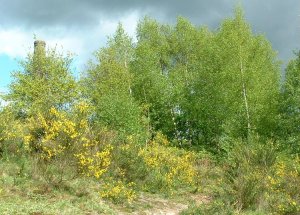 The lower slopes and richer soils on Troopers Hill are covered in scrubby areas and woodland. Trees and shrubs present include hawthorn, silver birch, oak, apple, broom and gorse.
The lower slopes and richer soils on Troopers Hill are covered in scrubby areas and woodland. Trees and shrubs present include hawthorn, silver birch, oak, apple, broom and gorse.
The broom (for which Troopers Hill is the best site in the city) and gorse are easily recognised by their attractive yellow flowers.
The scrub is home to many small birds and mamals and notably the dark-bush cricket. There is also a lot of bramble which, while providing valuable wildlife habitat (and blackberries for local residents), needs control to stop it overwelming other species such as the broom.

Birdlife
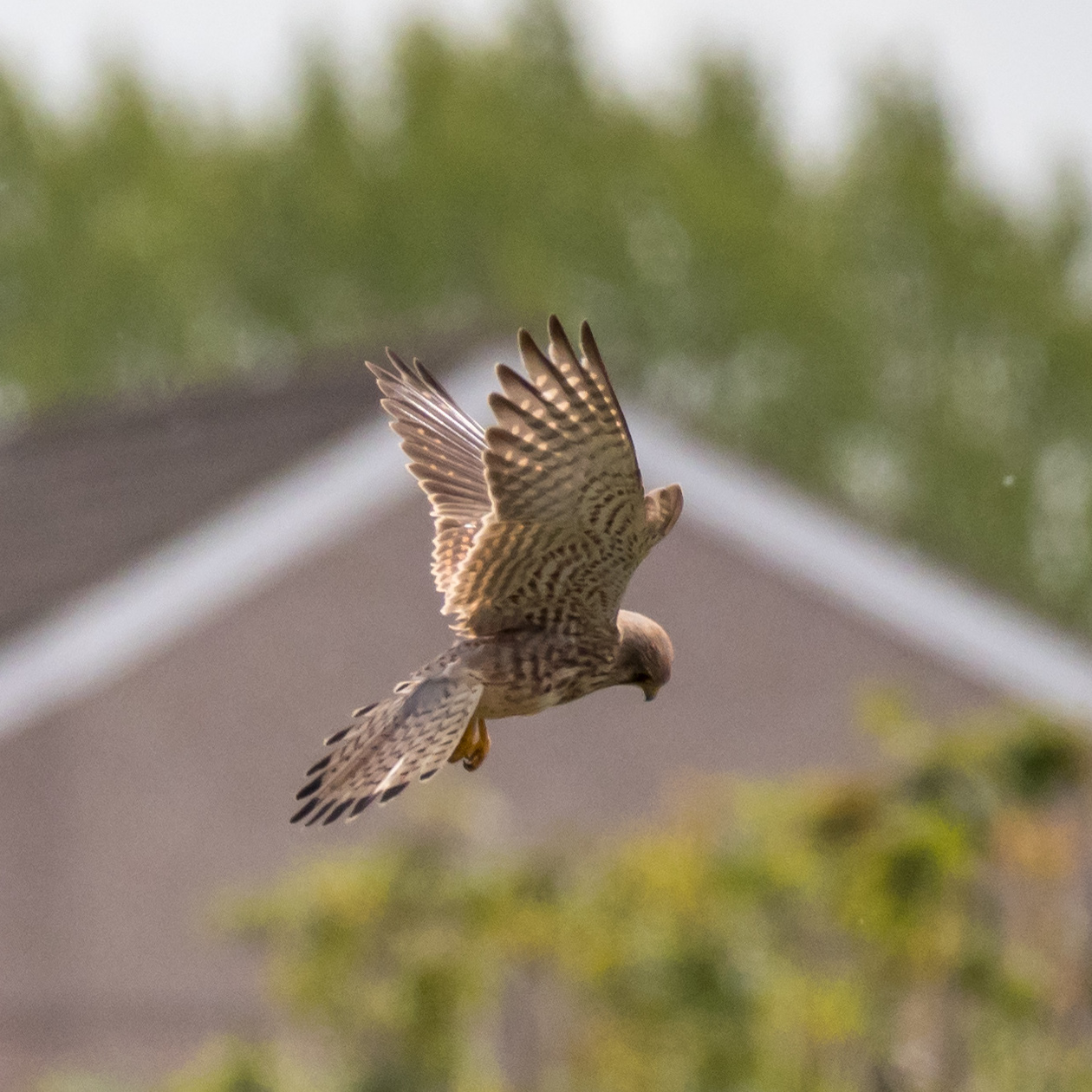 Many birds make their home on Troopers Hill and the surrounding woodland including Whitethroat, Chiffchaff, Willow Warblers, Blackcaps, Whitethroats, Goldcrests, Long Tailed Tits and Jays. There are also many of the more common songbirds such as Wrens, Blue Tits, Great Tits, Robins and Blackbirds.
Many birds make their home on Troopers Hill and the surrounding woodland including Whitethroat, Chiffchaff, Willow Warblers, Blackcaps, Whitethroats, Goldcrests, Long Tailed Tits and Jays. There are also many of the more common songbirds such as Wrens, Blue Tits, Great Tits, Robins and Blackbirds.
If you are lucky you will see Green Woodpeckers with their distinctive yellow rump visible as they fly away. Magpies are always present and can sometimes be seen fighting with Crows.
There are frequent sightings of buzzards circling the site. Kestrels were often seen hovering over the Hill in the late 1990. After a period where they were scarce, a pair seems to have taken up residence near by in 2021 so that sightings are more frequent, this photograph was taken by a resident of Firtree Lane.
A bird nesting survey was carried out as part of our Breathing Places Project in 2007 and in May 2008 we recorded the dawn chorus. Use the links to listen to the dawn chorus and download the report. We have also run several Dawn Chorus walks over the years and two bird walks in 2023.
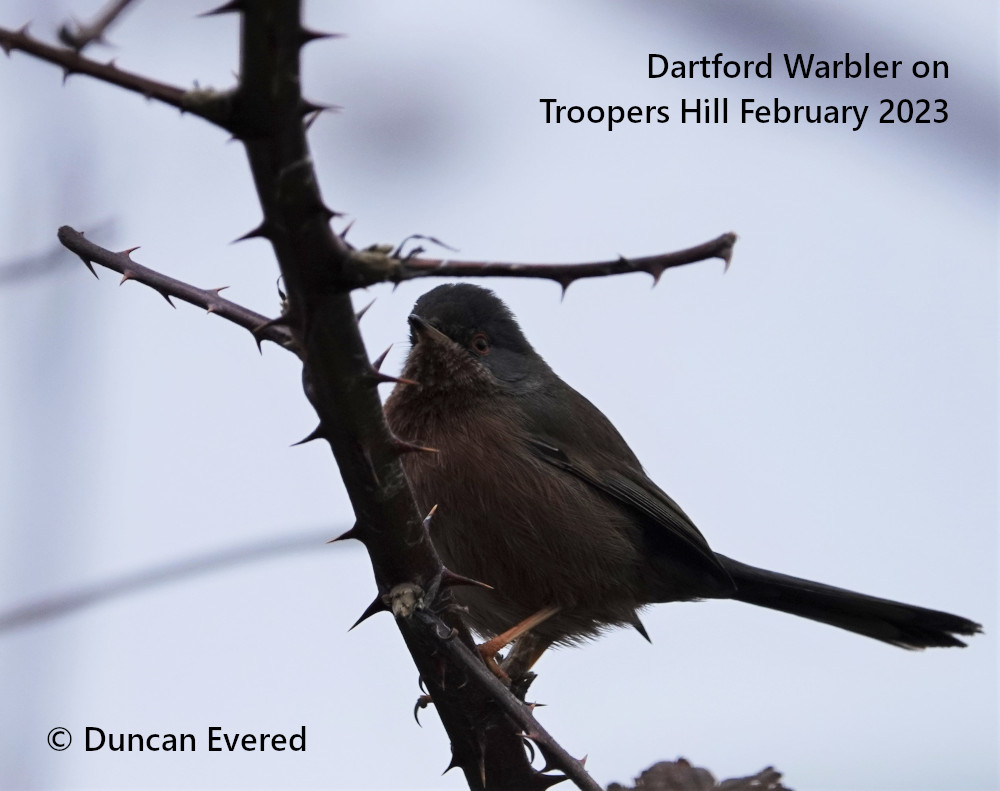 In autumn 2022 a single male Dartford Warbler was recorded at Troopers Hill and this was seen again in early 2023. Its presence attracted more birders than usual to the Hill.
In autumn 2022 a single male Dartford Warbler was recorded at Troopers Hill and this was seen again in early 2023. Its presence attracted more birders than usual to the Hill.
These birds breed on heathlands and nest in either gorse or heather; both of which are present on Troopers Hill.
Management of the site to protect the heathland, primarily to benefit the bees and other invertebrates that live there has obviously created a habitat that is atractive to this amber listed bird.
 Listen to the dawn chorus on Troopers Hill - May 2008
Listen to the dawn chorus on Troopers Hill - May 2008
 2007 Bird Nesting Report by Rupert Higgins
2007 Bird Nesting Report by Rupert Higgins
 Photos of a Green Woodpecker and a Wheatear taken in August 2007
Photos of a Green Woodpecker and a Wheatear taken in August 2007
 Audio Slideshow: Ed Drewitt talking about birds on Troopers Hill - April 2012
Audio Slideshow: Ed Drewitt talking about birds on Troopers Hill - April 2012
 Sightings recorded on eBird for Troopers Hill LNR
Sightings recorded on eBird for Troopers Hill LNR
 Sightings recorded on eBird for Crews Hole Woodland
Sightings recorded on eBird for Crews Hole Woodland
 Photographs on eBird for Crews Hole Woodland
Photographs on eBird for Crews Hole Woodland
 Bird Walks February 2023 report & photos
Bird Walks February 2023 report & photos

Bats
We know that a sizeable population of pipistrelle bats feed on the invertebrates flying above Troopers Hill on summer evenings. However, as far as we know there have not been any formal surveys and we would be fascinated to know what other bat species are around.
We were pleased to be contacted a local resident in 2025 offering to do some surveys for us. Jonathan is an ecologist and qualified to do bat survey work. He is in contact with Bristol City Council to gain permission to install bat boxes in Troopers Hill Woodland and carry out bat surveys.
If this permission is granted his employer, Arbtech Consulting Ltd, will be providing insurance for him to do this work free of charge.
Jonathan has also offered to lead bat walks for us in the future. As our last bat walk was in 2007 this offer was very gratefully received and we hope to arrange a date for 2026.

Other Mammals
 Troopers Hill and the adjacent woodland are home to badgers, foxes and deer, which move along the wildlife corridor of the Avon Valley. All are very secretive but you can come across them at anytime in the woodland and on the hill itself. This photo was taken in a garden near the hill and a deer can also be seen in this video on facebook.
Troopers Hill and the adjacent woodland are home to badgers, foxes and deer, which move along the wildlife corridor of the Avon Valley. All are very secretive but you can come across them at anytime in the woodland and on the hill itself. This photo was taken in a garden near the hill and a deer can also be seen in this video on facebook.
As well as these larger animals there are numerous smaller mammals such as mice, shrews and voles. Some of these were identified in a Small Mammals Survey undertaken by Ivan Packer, a student at the University of Bristol in Janury 2008.
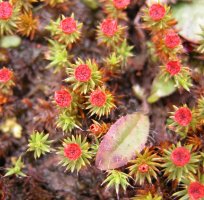 The pennant sandstone underlying Troopers Hill has resulted in acid soils, which are rare in Bristol. This has encouraged a wealth of plants to flourish that are found nowhere else in the City. You can also see and hear many different birds and if you are very lucky, especially early in the morning, you might even see deer.
The pennant sandstone underlying Troopers Hill has resulted in acid soils, which are rare in Bristol. This has encouraged a wealth of plants to flourish that are found nowhere else in the City. You can also see and hear many different birds and if you are very lucky, especially early in the morning, you might even see deer. ![]() Full list of Troopers Hill wildlife surveys >>
Full list of Troopers Hill wildlife surveys >>
![]() See wildlife records on and around Troopers Hill on iNaturalist >>
See wildlife records on and around Troopers Hill on iNaturalist >>
![]() The rocks and acidic soil of Troopers Hill >>
The rocks and acidic soil of Troopers Hill >>




 Beeflies
Beeflies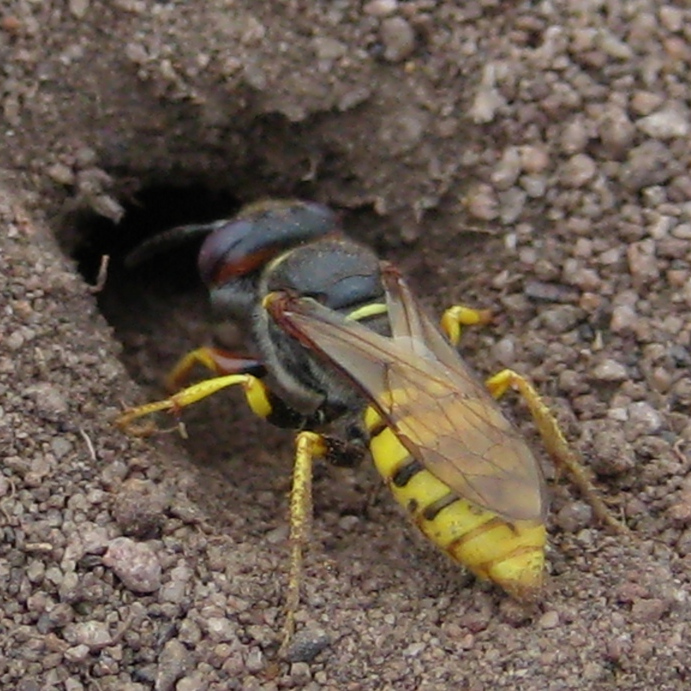 Another invertebrate you might spot digging holes in Troopers Hill are wasps. There is a wide range of wasp species in addition to the well known social wasps that might visit your picnic and also nest on Troopers Hill (
Another invertebrate you might spot digging holes in Troopers Hill are wasps. There is a wide range of wasp species in addition to the well known social wasps that might visit your picnic and also nest on Troopers Hill (
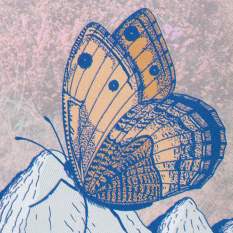 Grayling Butterfly
Grayling Butterfly Keri, took this picture a few metres from the flag on the Greendown entrance in Spring 2020.
Keri, took this picture a few metres from the flag on the Greendown entrance in Spring 2020. Many birds make their home on Troopers Hill and the surrounding woodland including Whitethroat, Chiffchaff, Willow Warblers, Blackcaps, Whitethroats, Goldcrests, Long Tailed Tits and Jays. There are also many of the more common songbirds such as Wrens, Blue Tits, Great Tits, Robins and Blackbirds.
Many birds make their home on Troopers Hill and the surrounding woodland including Whitethroat, Chiffchaff, Willow Warblers, Blackcaps, Whitethroats, Goldcrests, Long Tailed Tits and Jays. There are also many of the more common songbirds such as Wrens, Blue Tits, Great Tits, Robins and Blackbirds.
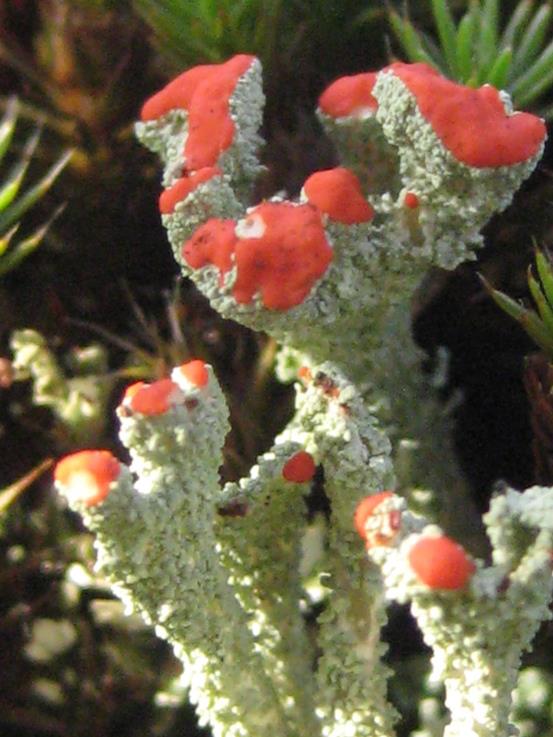 As well as the mosses mentioned at the top of this page the grassland and heathland on Troopers Hill houses an amazing range of fungi and lichen.
As well as the mosses mentioned at the top of this page the grassland and heathland on Troopers Hill houses an amazing range of fungi and lichen.
